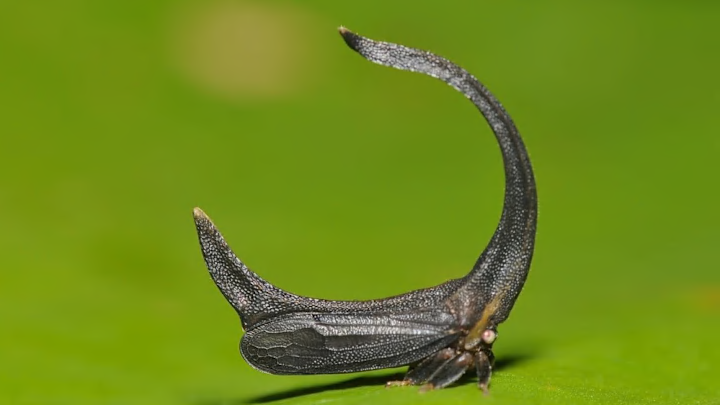These tiny insects come in eye-popping shapes.
Treehoppers are tiny wonders. Found on every continent save Antarctica, these insects have helmet-like structures that come in spectacular shapes. Some look like plant thorns or bull horns, while others are dead ringers for alien spacecraft. Incredibly, the helmets evolved from a third set of wings. Scientists estimate there are more than 3000 species worldwide, which belong to three separate families (Melizoderidae, Aetalionidae, and Membracidae).
These insects eat sap, using their sharp mouths to pierce plants and slurp up their fluids. As they eat, they squirt sugary waste called honeydew out of their rears. Some ants, wasps, and other creatures hang around treehoppers to drink the honeydew, and in exchange, the ants protect their sugary treehopper friends from predators.
Treehoppers can also communicate with each other by sending vibrations along plants, and many are gregarious, with parents and young hanging out together in large groups. Here are 12 surprising photos of these strange insects.

There are more treehopper species in the tropics than anywhere else. You’ll find this amazing C-shaped hopper in Ecuador. (Image credit: Pavel Kirillov via Flickr // CC BY-SA 2.0)

Sometimes, a treehopper’s helmet makes up a large chunk of the treehopper.

Why do they have such wacky headgear? Nobody knows for sure. Scientists think it might be for camouflage or protection—and there’s evidence that the helmets may have sensory properties, too.

All of the “thorns” on this plant are just treehoppers in disguise. Some thorn-mimicking treehoppers will quietly scoot to the other side of the stem if you approach. (Image credit: Marshal Hedin via Flickr // CC BY-SA 2.0)

A treehopper's thorny disguise is a lot less effective when it's not on a plant stem.

The buffalo treehopper can be found in the U.S. It looks less like a buffalo and more like an alien spacecraft, and it can be a pest on fruit trees.

Though these close-up shots make treehoppers look like looming monsters, don’t be afraid: these insects tend to be tiny.

The headgear of this species, Cyphonia clavata, is truly bizarre: It looks like an ant that’s facing the other way. Cyphonia clavata is not the only small creature that mimics ants. Other insects and even spiders do it too. (Image credit: Graham Wise via Wikimedia Commons // CC BY 2.0)

Many treehoppers have special relationships with ants. The ants drink a sweet liquid squirted out of the treehoppers’ rears, and in exchange, they defend their sugary pals. Some treehoppers even make alarm calls that encourage ants to mount a defense.

The Lantana treehopper may look like a bristly nightmarish unicorn, but it’s helping to control an invasive weed called Lantana in Australia. (Image credit: James Niland via Wikimedia Commons // CC BY 2.0)

Many treehoppers have ragged shapes that look bizarre up close, but blend into chewed-up foliage from afar. (Image credit: USGS Bee Inventory and Monitoring Lab via Flickr // Public Domain)

Next time you’re out in nature—or even a city park—take a closer look. Treehoppers are hiding everywhere. A nearby thorn, leaf, or even blob of bird poop might have eyes. (Image credit: Pavel Kirillov via Flickr // CC BY-SA 2.0)
